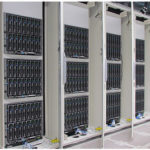In previous articles (1 and 2) here on insideHPC, James Reinders described “Intel Xeon Phi processor Programming in a Nutshell” for Intel’s 72-core processor. In this special guest feature, he discusses cluster modes and the interaction of the memory modes with these cluster modes.
Intel Xeon Phi Cluster Mode Programming (and interactions with memory modes) in a Nutshell
Berkeley Lab Tunes NWChem for Intel Xeon Phi Processor
A team of researchers at Berkeley Lab, PNNL, and Intel are working hard to make sure that computational chemists are prepared to compute efficiently on next-generation exascale machines. Recently, they achieved a milestone, successfully adding thread-level parallelism on top of MPI-level parallelism in the planewave density functional theory method within the popular software suite NWChem. “Planewave codes are useful for solution chemistry and materials science; they allow us to look at the structure, coordination, reactions and thermodynamics of complex dynamical chemical processes in solutions and on surfaces.”
Megware to Install CooLMUC 3 Supercomputer at LRZ in Germany
“The new CooLMUC 3 system outperforms its predecessors in a number of respects, including its key feature of cooling in thermally insulated racks all compute and login nodes, power supply units, and Omni-Path switches directly with hot water, a combination the likes of which has never been seen before,” said Axel Auweter, Head of HPC Development at MEGWARE. “Even at a cooling water temperature of 40 degrees Celsius and a room temperature of 25 degrees Celsius, a maximum of just 3% waste heat is produced in the ambient air.”
Creating Applications with the Intel Computer Vision SDK
“In order for developers to be able to focus on their application, a Vision Algorithm Designer application is included in the Intel Computer Vision SDK. This gives users a drag and drop interface that allows them to create new applications on the fly. Large and complex workflows can be modelled visually which takes the guesswork out of bringing together many different functions. In addition, customized code can be added to the workflows.”
Intel Xeon Phi Memory Mode Programming (MCDRAM) in a Nutshell
James Reinders discusses one of the “mode” options that Intel Xeon Phi processors have to offer: memory modes. “For programmers, this is the key option to really study because it may inspire programming changes.”
SDSC Seismic Simulation Software Exceeds 10 Petaflops on Cori Supercomputer
Researchers at SDSC have developed a new seismic software package with Intel Corporation that has enabled the fastest seismic simulation to-date. SDSC’s ground-breaking performance of 10.4 Petaflops on earthquake simulations used 612,000 Intel Xeon Phi processor cores of the new Cori Phase II supercomputer at NERSC.
NSF Funds HPC Cluster at Penn State
The Penn State Cyber-Laboratory for Astronomy, Materials, and Physics (CyberLAMP) is acquiring a high-performance computer cluster that will facilitate interdisciplinary research and training in cyberscience and is funded by a grant from the National Science Foundation. The hybrid computer cluster will combine general purpose central processing unit (CPU) cores with specialized hardware accelerators, including the latest generation of NVIDIA graphics processing units (GPUs) and Intel Xeon Phi processors.
Six Steps Towards Better Performance on Intel Xeon Phi
“As with all new technology, developers will have to create processes in order to modernize applications to take advantage of any new feature. Rather than randomly trying to improve the performance of an application, it is wise to be very familiar with the application and use available tools to understand bottlenecks and look for areas of improvement.”
Designing HPC & Deep Learning Middleware for Exascale Systems
DK Panda from Ohio State University presented this deck at the 2017 HPC Advisory Council Stanford Conference. “This talk will focus on challenges in designing runtime environments for exascale systems with millions of processors and accelerators to support various programming models. We will focus on MPI, PGAS (OpenSHMEM, CAF, UPC and UPC++) and Hybrid MPI+PGAS programming models by taking into account support for multi-core, high-performance networks, accelerators (GPGPUs and Intel MIC), virtualization technologies (KVM, Docker, and Singularity), and energy-awareness. Features and sample performance numbers from the MVAPICH2 libraries will be presented.”
PRACE Posts Best Practice Guide for Intel Xeon Phi
The European PRACE initiative has published a new Best Practice Guide for Intel Xeon Phi, Knights Landing Edition. “This best practice guide provides information about Intel’s MIC architecture and programming models for the Intel Xeon Phi co-processor in order to enable programmers to achieve good performance of their applications. The guide covers a wide range of topics from the description of the hardware of the Intel Xeon Phi co-processor through information about the basic programming models as well as information about porting programs up to tools and strategies how to analyze and improve the performance of applications.”











